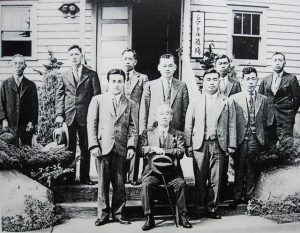Kano
Kano considered judo training to be an aid to the student’s educational aspirations. His ultimate ambition was to produce students of fine character, so that they would in future become useful, educated citizens and thus benefit society.
THE ETHOS OF JUDO
‘The purpose of judo is to perfect oneself physically, intellectually and morally for the benefit of society.’
Professor Jigoro Kano (1860-1938)
(The Father of Judo, Kodansha International, 2000)
(IL Padre Del Judo, Edizioni Mediterranee, 2005)
(Judo Memoirs of Jigoro Kano, Trafford Publishing, 2008, 2014)
(Memorias de Jigoro Kano, Editora Cultrix, 2011)
JIGORO KANO’S
1936 VISIT TO
SEATTLE DOJO
by
Brian N. Watson
Before the great expansion in air travel that started in the 1950s, most passengers journeyed overseas on ocean liners. One of the ships that often sailed the Japan – U.S.A. routes was NYK Line’s workhorse the Hikawamaru. This cargo-passenger liner reportedly made the two-week trip between Yokohama and the then gateway to the US, Seattle, 254 times between 1930 and 1960 when she was finally decommissioned and became a floating restaurant and later refurbished (2006-2008) and reopened as an Important Cultural Property permanently moored at the port of Yokohama. Professor Jigoro Kano, who made some 13 extended overseas trips in his lifetime, on occasions voyaged on the Hikawamaru, as did many other celebrities of the day.
The Seattle Judo Club, established in 1902, was reportedly the very first judo dojo to open on US soil. Jigoro Kano (1860-1938) seated in the centre of this photograph, called at this dojo twice, once in 1936 and again in 1938.
After attending the International Olympic Committee meeting held in Cairo, Egypt, in 1937, he later visited several European cities, then New York, Seattle and finally Canada. On April 23, 1938 Kano headed home and left Vancouver Harbor on the Hikawamaru, which was scheduled to arrive at Yokohama on May 6. However, he did not live to see his homeland again. En route, at the age of 77; he succumbed to pneumonia and died on this vessel on May 4, 1938.
Brian N. Watson
Tokyo
30 October 2016
References: (The Father of Judo, Kodansha International, 2000)
(Judo Memoirs of Jigoro Kano, Trafford Publishing, 2008)
Seattle Judo Club photograph courtesy of Ken Morinaka
Kano considerava l’allenamento del Judo come supporto alle aspirazioni educative degli studenti.
La sua aspirazione era quella di produrre studenti di carattere, che in futuro potessero diventare cittadini utili ed educati e pertanto di beneficio per la società.
IL TEMPERAMENTO DEL JUDO
L’obiettivo del Judo è quello del perfezionamento fisico, intellettuale e morale della persona a beneficio della società.
Professore Jogoro kano (1860-1938)
VISITA DI JIGORO KANO NEL 1936 AL DOJO DI SEATTLE
Da Brian N.Watson
Prima dell’inizio dell’espansione del trasporto aereo iniziata negli anni 50, la maggior parte dei passeggeri viaggiavano oltremare attraverso le linee oceaniche.
Una delle navi impiegate sulla rotta USA-Giappone era il cavallo di battaglia della NYK, la Hikawamaru.
Questa nave mista, cargo e passeggeri, era impiegata nella traversata della durata di due settimane fra Yokohama e quella che era allora la porta d’ingresso agli USA, Seattle.
La nave fece 254 viaggi fra il 1930 ed il 1960, anno in cui venne dismessa diventando un ristorante galleggiante.
Ristrutturato poi fra il 2006 ed il 2008 diventò poi un’attrazione culturale, rimanendo all’ancora nel porto di Yokohama.
Il professor Kano fece 13 viaggi oceanici nel corso della sua vita, ed in diverse occasioni viaggiò sulla Hikawamaru, così come fecero altre celebrità del tempo.
Il Judo Club di Seattle, aperto nel 1902, fu il primo dojo di judo inaugurato in suolo americano.
Jigoro Kano, seduto al centro della foto, visitò due volte il dojo, nel 1936 e nel 1938.
Dopo aver visitato il Comitato Olimpico Internazionale a El Cairo, Egitto, nel 1937, fece poi visita a diverse città europee per approdare poi a New York, Seattle e finalmente il Canada.
Il 23 aprile 1938 Kano ripartì verso casa lasciando il porto di Vancouver a bordo della Hikawamaru, che sarebbe dovuta arrivare a Yokohama il 6 Maggio.
Purtroppo non visse abbastanza per rivedere la sua terra di nascita, durante il viaggio, precisamente il giorno 4 maggio 1938, all’età di 77 anni morì a causa di una polmonite.
Brian N.Watson



